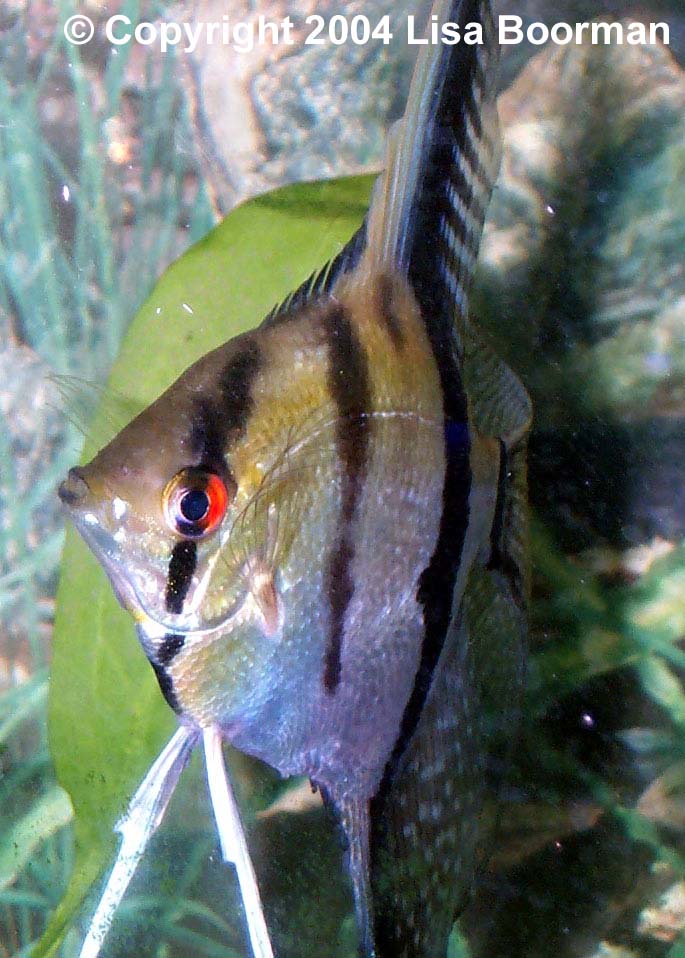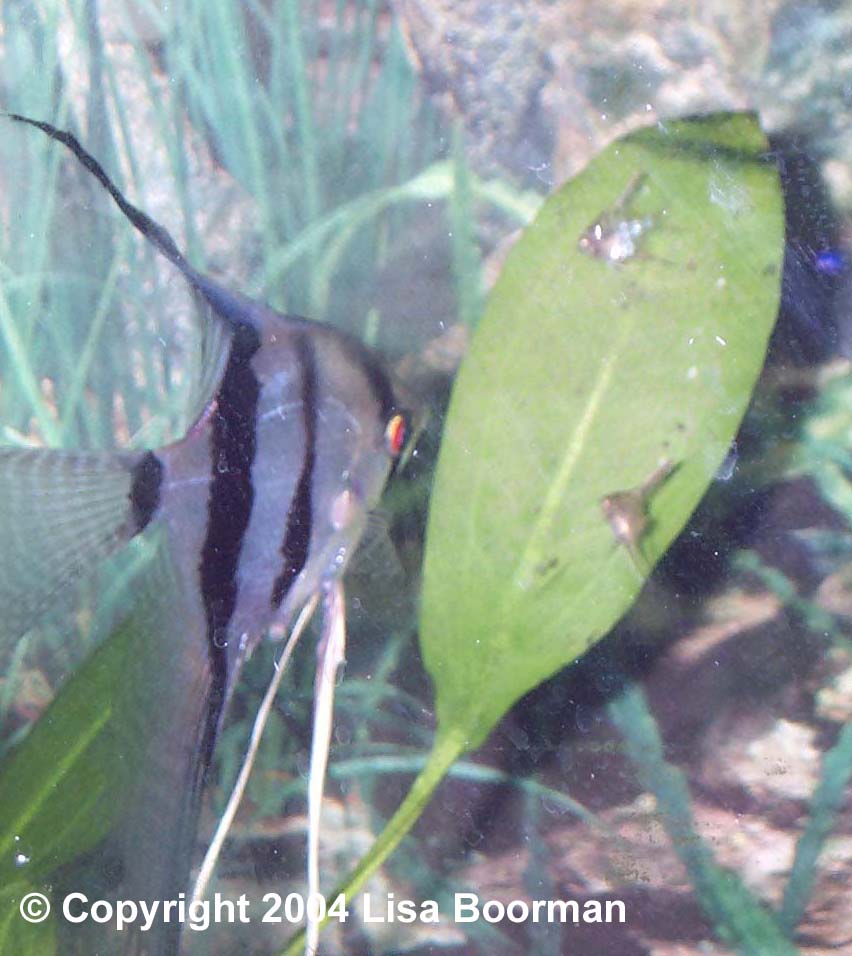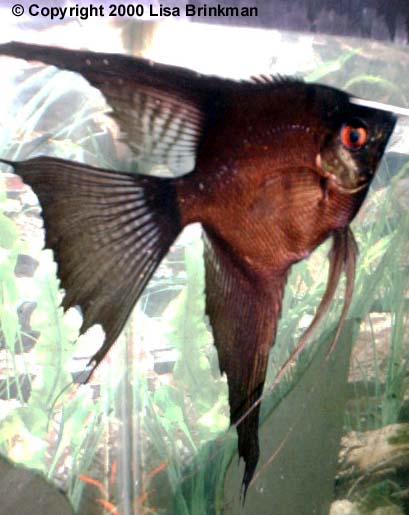There have been many species described in the genus but currently there are only three recognized. They are P. scalare, P. altum and P. leopoldi. P. scalare and P. leopoldi have synonyms. Scalares have also been known as Pterophyllum eimekei, Pterophillum eimekei, Plataxoides dumerilii, Pterophyllum dumerilii, Zeus scalaris, and Platax scalaris. P. leopoldi just has one synonym, Plataxoides leopoldi. P. scalare was described in 1823 by M.H.C. Lichtenstein. Almost all the freshwater angelfishes in the hobby are P. scalare.

The first angelfish were imported into Hamburg, Germany in 1909. However, they were unsuccessful in breeding them at that time. The first successful spawning and raising of fry occurred in 1921 (at least in the USA). These fish were very expensive in those days. They were selling pairs of them for $75 in 1915! Can you imagine what sort of money that is today?
Angelfish come from the Amazon River basin in South America. This includes Peru, Colombia, Brazil, Guiana and French Guyana. They are usually found in river systems. They are perfectly coloured to hide among roots or other riverine vegetation. They can be found in both white and black water habitats.
Angelfish can get quite large, having a body 6” (15cm) long. When you start adding in fins (especially veil varieties), you can add another 4” (10cm) to that length. Angelfish are usually taller than they are long, since the dorsal and pelvic fins are quite long as well. The height can be 8” (20cm).
Since angels are such a tall fish, it’s better if you have a tall tank so they are not cramped. As angels are cichlids, they also have their nature. You need space to house more than two angels. You need a group of them to get along in a large tank, or only a breeding pair in a smaller tank. A 20 gallon tank will be big enough for a spawning pair. A nicely planted tank full of angels and other fish makes a wonderful display in your house. However, if your goal is to raise baby angels, then you might take another approach.
Many breeders use what’s called a bare tank. This will basically consist of a “bare” tank, a heater, a filter and a slate for the angels to spawn on. There will be no gravel or other substrate in the tank, so as to make cleaning the tank much easier.
Keeping angels is fairly simple if you give them the space they require. The pH of the water is no longer as important as it used to be for them, since they’ve been bred for many years in the hobby. A pH of 6-8 will do fine for them. Some claim that the harder water makes it tougher for the eggs to hatch, but people have been breeding them in harder water for years now. The suggested temperature for keeping angels is 75F(24C)-86F(30C). Personally, I like keeping my fish on the lower end of the scale as it tends to keep the fish at a lower metabolism. I’m not in the industry of trying to pump out as many fry as possible.
After a male and a female have pair-bonded, they usually pick a spot to lay their eggs. They will carefully clean it prior to laying any eggs. In the wild, angels tend to lay eggs on plant leaves. They will also do this in an aquarium if there are any suitable plants in there. Thoughtful aquarists will place a slate in the tank for the angels to spawn on if they don’t have a plant that the angels like. However, sometimes angels will spawn on just about anything. I’ve had angel pairs spawn directly on heaters, which results of course, in the death of the eggs from being heated too much.
A large spawn can consist of easily 500 eggs. Both the male and the female will guard the eggs. The eggs will hatch in approximately 2 ½ days (about 60 hrs) dependant on the water temperature. At this point the fry are attached to either the slate or sometimes even moved and placed on another object in the tank to be further cared for until they are free-swimming. This will happen in another 5 or so days. You should not feed the fry until they are free-swimming.
The best thing to feed baby angels is newly hatched baby brine shrimp. If you’ve left the babies in with the parents, the parents will just as greedily eat the brine shrimp too. Most angel pairs are not good parents anymore. Most people steal the eggs after they are laid since many pairs tend to eat either the eggs or fry. I like the idea of raising the babies in with the parents at least for a while. It’s a beautiful scene watching a tankful of little angels being guarded by their attentive parents. After about 5 weeks, you can start adding in some finely crushed flake. The young angels seem to realize that it’s food, and have no problems eating it.
Since angels have been in the hobby a very long time now, many varieties have evolved. There are nine basic types of angels. All the others are combinations of these nine. They are as follows: Silver (wild type), Albino, Black, Half Black, Marble, Gold Marble, Gold, Zebra and Smokey

My latest adventures with angels occurred earlier this year when I saw the best angels I’ve ever seen in a pet store. They were basically wild type, but with a yellowish-orange cast to the top of the front of their body. They were both veils and had the longest dorsal and ventrals I’ve seen on an angel. They were also breeding size. They were obviously a pair since they were both trying to crowd all the other angels in the tank over to one side. They were also on sale! How could I resist such a deal? I cleared out a 20 gallon tall tank for them.
I redecorated the tank for them. I like my tanks at least somewhat aquascaped so I added some sand for the bottom, and placed a potted swordplant (Echinodorus sp. –most likely bleheri) in as well. I put in a slate on one side so they had lots of choice. There is a hydrosponge filter in the tank as well. The next day they laid a bunch of eggs all down the slate. I was happy to see that it appeared that I had a breeding pair. Of course, they ate these eggs within a few days. Not one to give up that easily, I let them stay in the tank and kept feeding them well.
I fed the parents on brine flakes as well as live baby brine shrimp. Some regular flake was added in for variety. They promptly spawned and ate eggs a few times. I figured that I might eventually have to steal the eggs, and hatch them out the hard way. I really did not want to do this. On September 25, the angels laid a large amount of eggs on the slate. Some of the eggs fungused, but the majority of them hatched. Shortly before the fry were freeswimming (Oct. 2), the parents moved them to the other side of the tank, and put them all on the swordplant. Some ended up on leaves, while others fell and stayed near the base of the plant. All were carefully guarded. I got bitten by the female protecting her babies from the siphon.
The fry continued to grow and then the parents spawned again. I got worried that they would eat the fry at this point, so I stole approximately 80% of the fry, and placed them in a bare 30 gallon tank with a few sponge filters. The parents still were guarding the first
 batch of fry. I then
noticed the fry were trying to eat the eggs, and that the parents did
not see them as a threat to their latest batch. The eggs went bad. I
wasn’t worried about saving these ones as I did not have another spare
tank for more angels. I figured that since the parents didn’t
worry on the fry I wasn’t going to for a bit either, knowing that it
would be at least 10 days or so before they would lay more eggs.
batch of fry. I then
noticed the fry were trying to eat the eggs, and that the parents did
not see them as a threat to their latest batch. The eggs went bad. I
wasn’t worried about saving these ones as I did not have another spare
tank for more angels. I figured that since the parents didn’t
worry on the fry I wasn’t going to for a bit either, knowing that it
would be at least 10 days or so before they would lay more eggs. The fry were being fed baby brine shrimp. This was being fed to both tanks, so the parents got the benefit of the babies meals as well. After another 8 days or so, I decided that I wouldn’t push it on if the parents would still accept the fry if they laid more eggs. I moved the last few fry into the other tank with the original fry that I stole. The fry from the parents tanks were obviously bigger than my originally moved fry. So far the young angels are growing well. I think I picked the right time to keep the fry with the pair, as they’ve eaten every batch of eggs laid since. They have also taken to laying the eggs on the swordplant now.
I’ve really enjoyed this experience with the angelfish as this is the first time that the parents have taken such great care of their fry. The fry continue to grow well in their tank.
